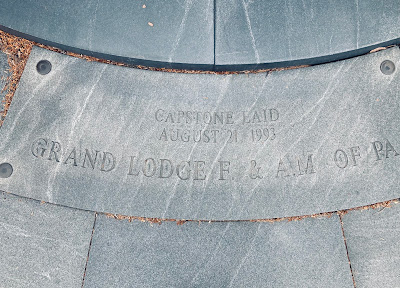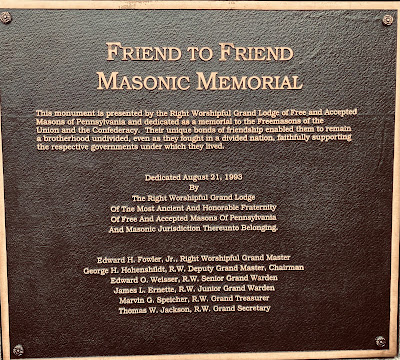Civil War Lodge of Research 1865 met at Good Samaritan Lodge 336 in Gettysburg last month and, during some down time at the end of that weekend, I finally had a minute to visit it. Very easy to find, I should say. Go to Tommy’s Pizza (itself marking fifty years in 2023) at 105 Steinwehr Avenue; walk across the street to enter the Cemetery Annex; and you can see it from the sidewalk. Just walk in.
The sculptures are more impressive in person than from most photos I’ve ever seen because everyone kind of shoots the same photograph: a front-on shot from about twenty feet out, to get the entire monument in the frame. But it’s art, so it tells a story. Here, I’ll intersperse my photographs amid the history imparted on Good Samaritan’s website:
The Friend-to-Friend Masonic Memorial was originally commissioned by the Grand Lodge of Pennsylvania, and was finished and dedicated as a memorial to the Freemasons of the Union and the Confederacy in the National Cemetery Annex on August 21, 1993. This date marked the first time that a private organization had been permitted to erect a monument in a national historic park.
The dedication of the Monument was the culmination of almost a decade’s worth of work planning, obtaining approval from Congress, coordinating various resources, and the bringing together of various agencies such as the National Park Service and the National Historical Society. All of this was accomplished by various members of Good Samaritan Lodge 336.
The Friend-to-Friend Monument depicts Confederate Brigadier General Lewis A. Armistead, a Freemason, wounded after crossing the wall during the climax of Pickett’s Charge on July 3, 1863, being attended to by Union Captain Henry H. Bingham, also a Freemason. Shown on the wall surrounding this monument, are the names of the States whose soldiers fought at the Battle of Gettysburg.
The story behind the monument goes that: prior to the war, General Armistead served with Union General Winfield Hancock in the Federal Army, and considered him a “valued personal friend.” However, when the Civil War broke out, General Armistead refused to raise his sword against fellow Southerners and he joined the Confederate Army in 1861. After 27 months of fighting the war, the units the two generals commanded met on the battlefield here in Gettysburg during Pickett’s charge. Both of the Generals were injured during the fight that day, but General Armistead was left to the mercy of the Union solders as he lay injured and the Confederate forces had been pushed back.
During the lull after the charge, a staff assistant to Winfield Hancock, Capt. Bingham of the Union, was riding past General Armistead who was lying on the ground where he fell. Capt. Bingham inquired as to who the wounded Southern General was, and General Armistead himself responded. After some conversation between Capt. Bingham and General Armistead, Armistead discovered whom Capt. Bingham worked for, and that Capt. Bingham was also a Freemason. Due to this, Armistead entrusted his personal possessions, including a pocket book, a watch, his spurs, and a chain with a masonic emblem on them to Capt. Bingham. These items were asked to be given to Capt. Bingham’s superior officer, Union General Winfield Hancock, so that they could in turn be returned to General Armistead’s family.






































































No comments:
Post a Comment